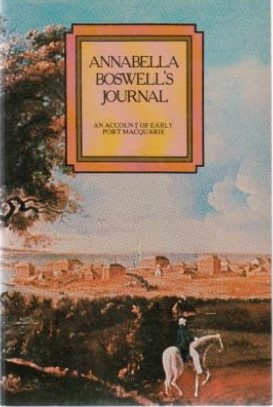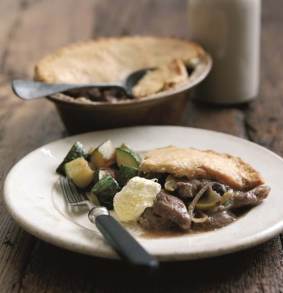Australian Women Writers Gen 1 Week 15-21 Jan. 2018

Annabella Alexandrina Campbell Innes “was born at Yarrows, near Bathurst in New South Wales in 1826, in September, which in that favoured land is a sweet spring month, when all nature is fresh and gay.”
Her father George, an eighth son then aged 20, had come out to NSW from Scotland with his older brother, Captain (later Major) Archibald Innes, 3rd Buffs, in 1823 and almost immediately took up grants of land at Winburndale Creek (“Yarrows”) and further north, a cattle station, “Glen Alice”, in mountainous and nearly inaccessible country near Capertee (then called Capita), maybe 200 km northwest of Sydney.
In November 1825 George married Georgianna “Moorshead, née Campbell” (which implies she was a young widow), also a Scot, in St John’s, Paramatta. “Miss E. Macarthur, of Elizabeth Farm, was one of the bridesmaids”. Ten months later Annabella was born.
At a young age, Annabella began keeping journals, and when later she married Patrick Douglas Boswell of Garrallan – a distant relative of the biographer – and then moved back home with him after he inherited the family estates in Scotland, she rewrote them for her children, according to the Publisher’s Note, as Early Recollections and Gleanings, from an old Journal. It is possible this was an intermediate stage as, according to the ADB
Some Recollections of My Early Days (1908) was republished as Annabella Boswell’s Journal (Sydney, 1965 and reprinted 1981 and 1993). Her vivid account of colonial life, Further Recollections of My Early Days in Australia (1911), was republished as Annabella Boswell’s Other Journal (Canberra, 1992).
This implies her writings were polished up again for the general public in 1908 and 1911 when Annabella Boswell was in her eighties (Later she writes that she is looking back 60 years which would be about right). She died at Garrallan in 1914.
Annabella writes that the family left Yarrows while she was an infant. It’s not clear where they lived for the next few years, but in 1834 they moved to Capertee and Annabella found herself “settled at school in Bridge Street, Sydney, under the care of Mrs Evans and her friend and partner, Miss Ferris. Mr Evans had a large bookseller’s and we occupied the rest of the house”.
At Easter the Tank Stream flooded Bridge Street and Annabella was sent to the Macleays. He was Colonial Secretary and her uncle, Major Innes’, father-in-law. Annabella remembers a dinner party where she was “much noticed by Mrs Sturt, afterwards Lady Sturt, wife of Captain Charles Sturt, who was then absent with an exploring party near the Murrumbidgee River.”
After a year at Mrs Evans’ Annabella’s father took her home to Glen Alice where she and her siblings were schooled by governesses. They seemed to have had an active social life with weddings and dances. In this context she mentions Ann Macarthur who MST tells me must be a daughter of Hannibal, John Macarthur’s nephew, and from the 1830s on, a member of the NSW Legislative Council.
Throughout, Annabelle and her family move almost entirely within the Scots community. A Presbyterian minister who includes Capertee in his rounds gives his service in Gaelic, and they have a shepherd who speaks only Gaelic. Even when Annabelle is being taught the kings of England, she begins at the Stuarts!
Annabella was a good diarist, both observant of people and her surroundings, and a fluent writer. While I enjoyed the references to the Macarthurs and Charles Sturt and so on whom I know from history books, the highlight of this book for me was the close descriptions of the logistics of getting into and out of Capertee. I have driven old trucks over Mt Victoria and out through Lithgow and Bathurst any number of times, not to mention Kandos and Wallerawang, so I can only marvel at the men who got horse and bullock wagons on unmade tracks through these mountains – at various times Annabella was in a gig that tipped over and pinned her underneath; her mamma was thrown from the back of a wagon that tipped when the horses bolted and a wheel broke; and of course they were bailed up by bushrangers.
The book’s subtitle is An Account of Early Port Macquarrie. The reason for this is that Major Innes built a mansion on his estate “Lake Innes” outside Port Macquarrie (400 km north of Sydney). George Innes’ health was failing and he took his family there in 1839 hoping for rest but was soon dead. Mrs Innes sold up Glen Alice and after a couple of years in Paramatta the family went back to Lake Innes to live.
At the peak of Major Innes’ uncertain prosperity, the grand house, liveried servants and unstinting hospitality gave Annabella a taste for the high life. Kilted pipers piped in the mornings and led the dances at night. Even the locals of the Birpai nation joined in:
When we went down again we found about twenty natives assembled there and dancing vigorously, while Bruce played. When they had finished, Dido proposed that we should dance a reel, and at once the whole party seemed inspired with a wish to join, and really there could not have been a gayer scene; we four girls in white frocks and pink sashes flying through the dance pursued by nimble partners ..
Life however was not without its problems. On Christmas Day, 1843:
It was very late when dinner was announced, the cook imagining it was a holiday (and making it one) had gone to sleep.
And so passed the 1840s as Annabella grew to womanhood – gardening, preserving fruit, drawing flowers, doing lessons, riding, bathing in the sea, rowing on the lake, entertaining endless visitors, and dancing. Of most concern is the news from London, via Sydney, of a new fashion in dresses:
Aunt Williamina asks her if we wear any stiff petticoats, and says she never wears less than two corded and stiff starched and one of horse-hair… I quite dread my own appearance so puffed out.
In 1845 a visitor arrives from India with “coolies” to be used as labour on his Darling Downs station. You might remember that Caroline Chisholm (here) was concerned that the virtual slave labour of convicts would be replaced by importing cheap labour from China and India. Annabella is more interested in their different colours and absence of dress, though she does mention some news from Sydney about Mrs Chisholm.
When the journal ends the colony is suffering an economic downturn and Port Macquarrie is virtually deserted; the house servants have ravaged the cellars and departed; Major Innes is in Sydney, and Annabella and her mother, too, are about to leave. The running of the Lake Innes estate had been predicated on the labour of convict servants. Transportation to NSW ended in 1840, and by 1848 Lake Innes was unviable. Major Innes was appointed police magistrate at Newcastle, and there in 1849 Annabella met Boswell.

Annabella Boswell, Annabella Boswells Journal, Angus & Robertson, Sydney, 1965 (this edition 1981). Introduction by Morton Herman. Cover painting: Port Macquarie in the 1830s by Joseph Backler (1813-1895)
See also AWW Gen 1 above for more on the first generation of Australian women writers.
Thank you for the Squab Pie – beef and apple sounds….interesting! As you know, I do love reading about food in books but particularly in historical fiction/ journals etc. It started with my great-great-grandmother’s diary as she sailed from Norway to Australia and described a banana, a fruit she’d never seen or eaten before (we had her journal translated many years ago).
I was also interested in the mention of the Tank Stream. When I was in Sydney a few weeks ago I stayed at a hotel called the Tank Stream and never paused to think about where the name came from (which is bizarre given that most of my working life has been spent in the water industry!).
Happy reading in 2018!
LikeLike
Annabella had lots of bananas in Port Macquarrie, and grapes for wine and brandy. Glad you liked the Tank Stream – I enjoy putting in links, I try and work out what references would be otherwise incomprehensible to an overseas (or in your case, a non-Sydney) reader.
Happy reading to you too as we forge our different paths through all those unread books.
LikeLiked by 1 person
I didn’t know about this Boswell – glad you’ve drawn my attention to it and what a nice coincidence she is a distant relative of the other Boswell.
LikeLike
Forget now how I found out about it. Bought it online, happy to lend you my copy.
LikeLike
Thanks Bill – don’t think I’ll get to it soon, but you reminded me I should read more diaries
LikeLike
Do you know the story of why her journals were published? Often we see journals published posthumously because the writer experienced something unique and of interest (like Anne Frank), or the person is already famous and readers want a more intimate look into the writer’s life (like L.M. Montgomery). Your writer did a lot, but I wonder if she is unique in her time.
LikeLike
She is unique in that we have almost no first hand accounts of pre-gold rush Australia, and those few by men – officials or explorers. Annabella was young, literate, living in the bush, and a woman. The only other accounts we have of women’s, and to a large extent, men’s lives are in those few surviving collections of letters.
LikeLike
Oooooh, very cool! What a treasure for Australia! I love the reviews a Canadian friends writes about people who first reached Canada from Europe and what THE WINTERS there are like. For reference, it’s currently -25C where I am in the northern States. (Yes, I had to Google the Fahrenheit to Celsius math!)
LikeLike
90F in Perth today, we’ve been having a mild summer. As for -25C! I’ve only ever been in snow a couple of times in my life. I even spent a week in February (years ago) in Copenhagen without seeing snow – very unfair.
LikeLike
[…] Gen 1 page Annabella Boswell’s Journal review Dale Spender, Writing a New World review Australia’s First Women Writers, Michelle Scott […]
LikeLike
[…] Annabella Boswell, Annabella Boswell’s Journal, wadh […]
LikeLike
[…] near Picton, and went to school at Sydney CEGGS. Her name reminded me of Annabella Boswell (here), also a Campbell, and the Scots community she moved in half a century earlier. But […]
LikeLike
[…] see also:Queensland Government, History of Bowen Indigenous Community (here)The Australian Legend, Australian Women Writers Gen 1 (here)Annabella Boswell, Annabella Boswells Journal, Angus & Robertson, Sydney, 1965 (here) […]
LikeLike